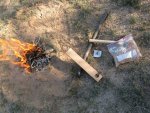Darton
Adventurer
When I was a boy scout we would always have a little competition between my patrol and the others in the troop when we'd go camping to see who could start a fire with the least amount of matches. Then once we mastered using only one match we moved on to which patrol could start a sustainable fire the quickest with a steel.
I remember we would always raid our parents clothes dryers at home before we met up for a trip. Also I would roll up strips of newspaper and tie them around with a piece of twine then melt some wax and soak the paper in the hot wax once it sets it makes an awesome waterproof fire starter, and were small and light enough to carry multiple ones on a trip. one was always plenty enough to get a camp fire going.
Having the fire starting challenges made doing it fun, and we were always concious of how to conserve resources when fire starting when we got older.
Look in a sboy scout handbook there's alot of fire startin knowledge in there along with different types of fire structures.
I remember we would always raid our parents clothes dryers at home before we met up for a trip. Also I would roll up strips of newspaper and tie them around with a piece of twine then melt some wax and soak the paper in the hot wax once it sets it makes an awesome waterproof fire starter, and were small and light enough to carry multiple ones on a trip. one was always plenty enough to get a camp fire going.
Having the fire starting challenges made doing it fun, and we were always concious of how to conserve resources when fire starting when we got older.
Look in a sboy scout handbook there's alot of fire startin knowledge in there along with different types of fire structures.


